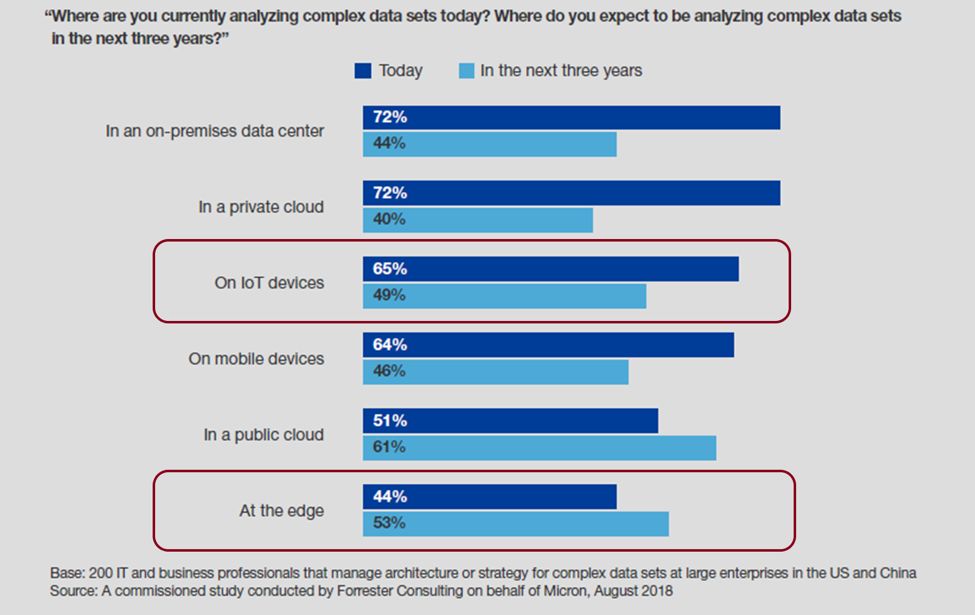
Edge computing has become an important trend in the Internet of Things .The Gartner Group identified edge computing as one of the major technology trends of 2019. Companies implementing IoT solutions are seeing the real benefits of processing data closer to the “things” at the edge before it is sent to the cloud. A recent survey by Forrester confirmed this trend, finding that 53% of respondents expect to analyze complex data sets at the edge within the next three years. This is why some boldly predict that “edge computing will eat the cloud.”

Edge computing is receiving increasing attention because it addresses some key issues in realizing industrial IoT use cases.
Edge processing of large volumes of sensor data reduces network bandwidth costs and cloud data storage costs. Edge computing allows for the analysis and filtering of data close to the sensors, so only relevant data is sent to the cloud.
Many industrial IoT use cases require sub-second response times for safety-critical and precise operations. For example, if a person gets too close to an industrial machine, they need to stop work immediately. In such cases, the decision to stop cannot wait for a response from the IoT cloud platform. Moving processing closer to the sensors at the edge allows for sub-second response times.
Autonomous vehicles are another use case that requires sub-second response times due to edge computing.
The security and privacy needs of industrial IoT use cases are also driving the demand for edge computing. Factories and critical infrastructure are using edge devices to protect critical industrial processes and equipment from direct network connections. Similarly, the data generated by these machines is often considered private and confidential, as edge computing can keep sensitive information within the factory.
Finally, edge computing also allows for autonomous operations. If there are network connectivity issues, many industrial operations cannot simply stop. Edge computing allows devices and factories to continue operating regardless of network availability.
1. Edge Computing Control
Edge computing has caught the attention of technology vendors. Small startups are creating dedicated edge computing stacks. IoT platform vendors have edge solutions that connect to IoT hardware vendors, and even open-source foundations are seeing potential opportunities in edge computing.
The market dynamics between different vendors and open-source communities are still evolving. Some vendors aim to provide a complete device-to-cloud solution, some are forming partnerships, while others are working in collaborative open-source communities. There is no clear leader, but it seems that some are achieving more success than others.
2. IoT Cloud Computing Vendors
IoT cloud providers focus on providing integrated end-to-end solutions for customers, including device-to-cloud integration. They make it easier for customers to build, deploy, and manage IoT devices connected to cloud platforms. For many customers looking to quickly launch new connected products, this is an appealing story. However, the risk of such integrated solutions is the potential for long-term vendor lock-in.
Amazon and Microsoft are the trailblazers among IoT cloud providers. Both companies have edge solutions that connect to their respective IoT cloud platforms. Amazon Web Services offers AWS IoT Greengrass, allowing connected devices to run AWS Lambda functions, perform machine learning, data synchronization, and connect to AWS IoT Core. Similarly, Microsoft IoT Edge allows connected devices to run MS Azure services. Microsoft has taken steps to make IoT Edge an open-source project on GitHub, which seems to make it easier to port IoT edge to other hardware platforms, although it appears tightly coupled with the Azure IoT Hub cloud platform.
Google has announced Cloud IoT Edge, which seems to focus on providing AI capabilities at the edge. Cloud IoT Edge is still in alpha testing. In the past, Google has also announced collaboration with the well-known edge vendor Foghorn.
3. IoT Platforms
Many IoT platform vendors are also developing their own edge products. Companies like Litmus Automation, Clearblade, Bosch IoT Suite, and Software AG Cumulocity offer edge solutions connected to IoT platforms. These companies focus on the ability to run data analytics and machine learning models on edge hardware.
Some of these vendors have also partnered with IoT hardware providers. For example, Software AG has collaborated with Dell and Eurotech to provide their edge software solutions on Dell and Eurotech hardware. The integrated hardware and software solutions will make it easier for these companies to market joint solutions to customers.
4. Advantage Vendors
There are many venture-backed startups focused on providing edge solutions. Companies like Foghorn and Swim specialize in edge machine learning and analytics. Others, such as Zededa and Edgeworx, are bringing virtualization and container technologies to edge devices.
All these companies are partnering with major IoT platforms and IoT cloud providers to connect their edge solutions to various IoT platforms. The challenge they will face is supporting all the different integrations, which are often based on vendor-specific APIs and protocols.
5. IoT Hardware Vendors
IoT gateway vendors are investing in software stacks that run on their hardware. These software stacks are becoming increasingly complex to meet the demands of edge computing use cases. Interestingly, many hardware vendors are building software solutions based on open-source projects.
Dell and Rigado both have IoT gateways running on the Ubuntu kernel, allowing for remote management and deployment of software running on their gateway devices. Dell is also a leader in the EdgeX open-source project for edge computing. Eurotech provides the Everywhere software framework based on Eclipse Kura for building edge computing applications. Taiwan’s large gateway manufacturer ADLINK has developed Vortex Edge and Vortex DDS to facilitate the deployment of software on their gateways. Vortex DDS is based on the Eclipse Cyclone DDS project.
6. Open Source Community
It is important to note that open-source foundations are getting involved in edge computing activities. Open-source foundations provide a vendor-neutral space for companies and individuals to collaboratively develop edge computing technologies. For companies concerned about vendor lock-in, particularly the siloed approaches of AWS and Microsoft, the emerging open-source community for edge computing offers an interesting alternative.
To a large extent, IoT cloud providers, IoT platform vendors, and edge startups have not participated in building collaborative open-source communities for edge technologies. Some have created their own open-source projects, but many still focus on providing vendor-specific commercial solutions. Commercial solutions are often built using open-source technologies, but these companies are not actively participating. However, the lack of participation from these vendors has not diminished the momentum for collaborative open-source projects focused on edge computing.
The Linux Foundation recently announced the LF Edge community. LF Edge includes five different open-source projects, including EdgeX and Zededa’s virtualization project, Project EVE. Sixty member companies, including Arm, AT&T, Dell, Ericsson, IBM, Intel, Huawei, Red Hat, Samsung, and others, have agreed to collaborate on a common framework for edge computing.
LF Edge is the largest open-source collaboration in terms of corporate sponsorship to date. Corporate sponsors seem to be those companies without strong IoT platforms, and thus they may view an open edge framework as a way to level the playing field. The task of integrating these five projects and new edge projects will be interesting. If they succeed, it will certainly challenge the single-vendor approach in IoT.
The Eclipse Foundation is one of the most mature open-source communities in IoT. Eclipse IoT was created six years ago and hosts over 30 open-source projects, including many for edge computing. Eclipse Kura is the flagship edge computing project of Eclipse, but there are also Eclipse ioFog and Eclipse fog05 for creating innovative edge technologies. Eclipse also hosts implementations of popular industry standards required for edge computing, such as MQTT, OPC-UA, DDS, CoAP, and LWM2M.
The OpenStack Foundation is also expanding into the edge computing space. The StarlingX project, based on Wind River’s code contributions, integrates various open-source projects, including CentOS, OvS-DPDK, Ceph, Kubernetes, and OpenStack, with the goal of running cloud services on edge devices. This project was launched in October 2018, making it relatively new.
Huawei and Baidu have also created their own edge computing projects on GitHub. Huawei is a major contributor to KubeEdge, which extends Kubernetes to the edge. This project was launched on GitHub in September 2018. Baidu just announced the openEdge project in January. openEdge seems to be integrated with Baidu’s IoT cloud platform, so it is unclear how independent this technology is.
7. Conclusion
Clearly, edge computing is an essential component of any IoT solution. Customers are benefiting from the innovation and diversity of edge computing solutions. There is a trade-off between the ease of use of cloud infrastructure provided by a single vendor and the costs of integrating solutions together, as well as the long-term avoidance of vendor lock-in. Over time, customers will often need heterogeneous computing solutions for distributed technologies like edge computing. If history repeats itself, the industry will address this issue by defining a set of common standards and protocols that define how edge and cloud communicate. Like web technologies, these standards and protocols are likely to be implemented by vendor-neutral open-source and standards communities.
Original link:
https://thenewstack.io/the-internet-of-things-on-the-edge/
↓↓ Click “Read Original” 【Join Cloud Technology Community】
Related Articles:
10 Major Predictions for Cloud Computing in 2019
6 Benefits of Multi-Cloud Platform Management You Must Know!
RightScale 2019 Cloud Status Report: 35% of Cloud Spending is Wasted [Includes 50-page PDF Download]
9 Major Trends in Cloud Computing in 2018: Serverless, Hybrid Cloud, Multi-Cloud, Middle Platform, Edge Computing, etc. [Includes Download]
Enterprise-level PaaS Cloud Platforms: Key Issues and Challenges Not to Be Ignored
More Articles Please Follow

Find the article interesting? Click here[Looking]👇